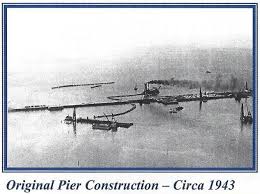There is no doubt I love the US Navy not only for its dedication to the nation and excellence of its officers and enlisted men and women alike, but also for its professionalism and perfection in every detail when writing official memos or documents.
So it came as a surprise, and a wonderful opportunity to read, how the US Navy’s first report of the Monmouth County land in both Colts Neck and the Bayshore where Naval Ammunition Depot, Earle, was built, was described for official records.
Although most of the report focuses on the Colts Neck side of the base, there is reference to the ‘romantic history” of the Leonardo side that describes what the Navy said this area was like in June 1943, when the Navy acquired the land.
Referring to the Colts Neck area, the report reads:
“Earle was, in the beginning, largely oak forest and woodland swamp, glen paradise for deer and other game. Pheasant and fox, deer and rabbit dwelt here in a world of their own, with only the baying of an occasional hound or the tread of an occasional hunter to astound them into seeking cover.
Even now, on bleak winter mornings, as we sit comfortably at breakfast in the windowed ward-room of our BOQ, we can smile to see a hen quail, like a plump little bandy-legged woman, waddling over the crusted snow to our charitable handout of bread crumbs, her little family aligned behind her. Even now, on hot summer nights, as we return tired through the magazine areas, we may stop breathless, as a stag, head lifted at the sound of our voices, stands in majesty, silhouetted against the rising moon atop a magazine.”
Clearly enthralled by the natural beauty of the area, the writer took notice of everything. He also showed his knowledge of history and the 19th century term that became popular once again during the Prohibition era. “Blind Pig” in the 1800s referred to a low-end bar or saloon ; it was reactivated during Prohibition to mean the same, and was generally considered to be a class lower than an ordinary Speakeasy.
The official Navy report continues, still referring to the Colts Neck side of the base:
“Along its fringes and roadways a few ‘blind pigs’ had blinked their pale eyes during the Volstead Era, and stories of violence in its quicksand are not yet entirely forgotten. Two of these legendary establishments still remained when the leveling the land for what was to be the Main Gate commenced.”
But the last paragraph in the official record of what preceded NAD Earle was reserved for the Bayshore side of the base. The writer said:
Leonardo, too, was not without its romantic history. Skirting its shores had stood a cluster of gay little houses of prostitution, too which harried New York business ladies were wont to retire during the summer months in order to ply their trade in a cooler, quieter atmosphere.”




What beautiful reading this was! Thank you, Muriel, for bringing this lovely writing on these lands we’ve been blessed with to our notice. This Navy scribe went above and beyond the mundane to accurately depict both the natural environment and the natural human beings who found respite here!
Comments are closed.